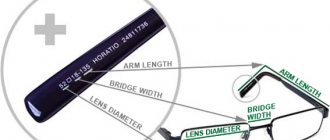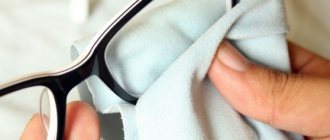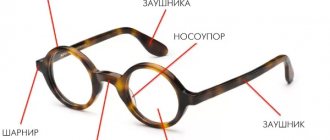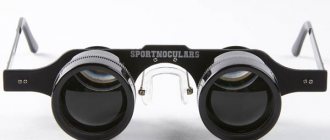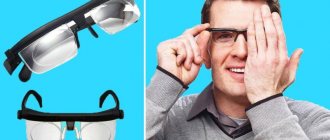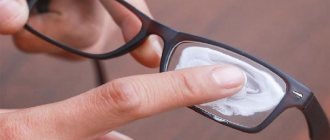As digital technology develops, more and more electronic gadgets appear - headphones, wireless headsets, etc. - which are designed to be placed behind the ear. There is no problem here, but only if you don't wear glasses. It doesn’t matter what kind of glasses they are - for vision correction or sun protection. One thing is obvious: in this case, you have too little space behind your ears to simultaneously place two devices at once (and glasses are also a device, only not electronic, but optical). This problem fully concerns users of behind-the-ear hearing aids.
Is it possible to somehow ensure a comfortable proximity of two devices at once when using them simultaneously?
Pince-nez
One of the names for glasses without temples. Pince-nez - glasses from the 18th–19th centuries. These glasses are attached to the bridge of the nose using a temple clamp. As a last resort a chain was attached to this device to prevent it from falling. In order to preserve the consumer qualities of the pince-nez for as long as possible, it was necessary to prevent the central spring from losing its elasticity ahead of time. Therefore, many copies were made foldable, and when folded they were fixed with a latch. With this storage idea, the spring was unloaded, and it could retain its elasticity for the entire period of use.
The original shape of the pince-nez was round, later oval pince-nez appeared, and in the 19th century its design was changed with the help of a wide variety of accessories. It was very difficult to choose pince-nez, because in addition to the initially necessary selection of lenses, it was important to choose the correct frame size. If this was not taken into account, the person would have good vision, but could get problems with the nose. Perhaps pince-nez surpassed ear-hook glasses in popularity and became the most common type of glasses for a time.
At the moment, this is a long-outdated piece of optics, which can only be seen in historical films. Today, pince-nez is a real rarity, which is found almost nowhere.
Symptoms of incorrect selection of glasses for vision
If you choose the wrong glasses for farsightedness, you may experience some discomfort in the eyes and head, itching in the eyes, burning, headaches, and fatigue.
The cause of poor health can also be a factor such as incorrectly measured interpupillary distance. This indicator should ensure correct alignment of the lenses in the frame. If the interpupillary distance is measured incorrectly, this leads to additional visual strain on the eyes.
Lorgnette
The word lorgnette comes from the French verb lorgner - “to squint”, because one of the purposes of a lorgnette is to observe objects located to the side. This verb in French means “secretly desire” , just for lorning, that is, close examination.
- A lorgnette is a type of aristocratic folding glasses that were equipped with a handle for ease of use.
- During the period from the 18th to the 19th centuries, these glasses were in great demand in secular society.
Because of their strong desire for knowledge, members of high society read all the time, and not always in good light. Beautiful ladies and stately men began to feel embarrassed about their own myopia, but ordinary glasses were considered bad manners - at this moment a lorgnette came to the rescue. The lorgnette was mainly used by the female half of the population. These glasses without arms were a kind of accessory decorated with mother-of-pearl, ivory and precious stones.
The lorgnette is an impressive thing and more reminiscent of a toy than a way to correct vision. Proper handling of a lorgnette was considered a real art form that any self-respecting courtier had to master. With the help of a lorgnette, Mademoiselle could express to her interlocutor both her personal disposition and his complete absence. For a long time, these glasses were constant companions of society ladies.
Lornettes were in no hurry to leave even after the spread of glasses purchased only for home use . As soon as a lady needed to go out, she chose a lorgnette. This model remained in catalogs until almost the end of World War II. Rodenstock's assortment in 1911, more than thirty different models of lorgnettes, the prices of which varied. Small selection of materials:
- celluloid;
- tortoiseshell.
Stylish colors and materials
If we talk about materials, glasses with plastic and metal frames will be in fashion. The main thing is that its material and assembly itself are of high quality (the same applies to the decor, if any). This will determine how long the glasses last and how they will look during use. On cheap models, the paint often peels off and the surface quickly wears off.
Advice ! If your budget allows, buy yourself several different pairs of glasses and change them depending on your mood. Even in “jeans + white basic t-shirt” looks, different glasses will play differently.
Of course, frames in basic shades will remain trendy:
- black;
- brown;
- gray;
- white or cream.
However, in 2021, designers recommend that we experiment in every possible way with the color of frames. They invite us to try on pink, blue, orange and lemon, red, peach and other colored frames. Glasses of this format really look very stylish and original.
Monocle
While ladies wore lorgnettes, men preferred monocles, which were kept on the face due to facial expressions, without any special device. The optical device was designed for people to correct the vision of only one eye. People with poor vision were forced to choose one of their eyes. The monocle is very comfortable, fits tightly into the eye socket and is small in size. Not all people could afford a monocle, because it was considered a luxury item that rich people possessed.
And yes, the most difficult thing lay ahead for emotional people: as soon as they were surprised and raised their eyebrows, it fell out. was attached to a piece of clothing to avoid loss was very helpful It was quite difficult to hold the monocle with his facial muscles, so his improvements continued. The monocle became very popular among officers and diplomats. Being an object of fashion, the monocle was worn by everyone, even those who did not have vision problems. Today the monocle has disappeared.
My opinion about the types of glasses without arms is this: it’s very good that at one time there were a lorgnette, a monocle, and pince-nez .
Each time has its own characteristics for both men and women. It is a pity that at the moment very few people use these inventions. Without them, it’s not so interesting; there are ordinary glasses or lenses around that are not visible to human vision from afar. I would buy myself at least one copy of the lorgnette.
Tips for choosing
First of all, glasses must always be purchased correctly, observing all optical parameters (for example, diopters or center-to-center distance). It is advisable that the glasses be of high quality, since their quality will ultimately affect visual acuity. If the wrong glasses or glasses of poor quality are selected, the eyes try to compensate for the caused optical distortions, overstraining the eyes, causing headaches, and this may also be the answer to why vision deteriorates.
When choosing glasses, special attention should be paid to spectacle lenses, namely:
- Optical parameters of lenses (center-to-center distance and diopters). These indicators will be obtained as a result of a vision examination.
- Lens refractive index. Refractive index is a very important indicator when choosing glasses. It is best to purchase lenses with a high refractive index, as they are lighter in weight and do not distort the eyes and face. As a rule, the higher the index, the thinner the lens. Lenses with a value of 1.5 are considered low-index. High index lenses start at 1.6.
- Spectacle lens material. In modern times, glasses lenses are made of glass or plastic. Plastic is light in weight and has a soft structure, so it is more susceptible to mechanical damage, such as scratches. However, plastic lenses are often coated with a hardening coating. Glass lenses have a higher refractive index and strength.
- Anti-reflex coating. This coating helps improve the optical properties of the spectacle lens, increasing its transparency by 8-10%. This anti-reflex coating makes your eyes feel less tired and more comfortable.
Before purchasing glasses, you must consult an ophthalmologist to rule out possible concomitant eye diseases. Data on the state of vision is obtained using a special device - an autorefractometer, which is usually installed in modern optical shops and hospitals. Visual acuity is checked using a special table.
Read more about children's glasses here.
When buying glasses, you must remember that the difference in diopters of both lenses should not be more than 2-3 diopters.
It is recommended to purchase glasses from specialized pharmacies or optical shops that guarantee the quality of the products sold and compliance with optical parameters.
Acuvue oasys toric lenses for astigmatism are a choice that doctors will approve of.
Find out how long you can wear lenses per month in this article.
Caring for long-term wear lenses:
How to choose glasses for your face shape?
Disclaimer ! Remember that your face is unique. The recommendations below are not the only correct solution. Try on different glasses and analyze how well they fit you and how they highlight the features of your face.
Now let’s figure out what shapes of glasses will suit each face shape.
Round face
The purpose of glasses is to visually lengthen the face and bring it closer to an ideal oval shape. The following frames will do the job perfectly:
- square, rectangular frames;
- cat glasses;
- aviators;
- Ray Ban style glasses.
Suitable and unsuitable frames for round faces
Those with a round face are not recommended to wear round and narrow glasses, models with unusual lens shapes, or mirrored glasses. Also, you should not choose models in which the frame covers the eyebrows.
Advice ! Dark frames look most beautiful on a round face; they give a visually narrowing effect.
Oval face
This face shape is considered the most complimentary; you can wear almost any glasses with it. The only important rule is that you do not need to choose frames that are disproportionate to the proportions of your face. Suitable for oval faces:
- cat glasses;
- round glasses;
- smooth square and rectangular models;
- butterfly glasses.
Choosing the perfect glasses for an oval face
On an oval face, overly massive or, on the contrary, narrow frames and sharply defined glasses do not look very harmonious.
Square face
On a square face, the main task of glasses is to smooth out the already sharp right angles. This will work well with:
- drop glasses;
- round glasses;
- oval glasses;
- cat glasses;
- aviators.
Glasses with colored frames or without them at all look beautiful on a square face.
The right glasses for a square face
Girls with a square face shape should avoid square glasses, too narrow and miniature frames. You should also not wear glasses whose frames are wider than your face. Such models will only exaggerate its shape even more.
Rectangular face
You always want to visually expand a rectangular face a little. Massive aviator glasses and models with rounded shapes will help in this matter.
Ideal glasses shapes for rectangular faces
Small and narrow frames are not very suitable for a rectangular face; it is better to avoid glasses of bright colors. Models with transparent or flesh-colored frames look ideal on this face shape.
Heart shaped face
With this face shape, you need to visually make the lower part of the face more massive, so that overall it becomes proportional. This task can be completed by:
- Ray Ban style glasses;
- elegant and small frames;
- rimless glasses;
- small aviators;
- glasses with low-set temples;
- round and rounded glasses.
Suitable glasses shapes for heart-shaped faces
If you have a heart-shaped face, it is better not to wear glasses in the shape of “droplets”, “cats”, “butterflies”, glasses with sharp corners, or too massive models. Also, you should not wear brightly colored glasses; it is better to replace them with options in calm natural shades.
Types of frames
Eyeglass frames are made from a variety of materials, and their choice is becoming more diverse every year. The materials for various types of frames are most often plastic and metal. But since natural materials have come into fashion, wood and animal bones are also used. Lovers of charm encrust frames with precious or semi-precious stones.
The most durable and rigid plastic for frames is polycarbonate. It will last a long time, since defects from a fall or impact are minimal. There are types of glasses with frames made of flexible materials that rarely break.
In the age of allergies, neutral materials that will not cause irritation to the skin are important. Titanium and stainless steel meet these requirements.
The nasal arch is being improved, where the emphasis is placed not only on appearance, but also on comfort. The nose and behind-the-ear parts of the frames are equipped with silicone pads so that the glasses do not slip and are securely fixed. They are transparent and invisible.

